Purchasing Habits, Sustainability Perceptions, and Welfare Concerns of Italian Consumers Regarding Rabbit Meat
Abstract
:1. Introduction
2. Materials and Methods
2.1. Quantitative and Qualitative Methods
2.2. Participants
2.3. Analysis
2.3.1. Qualitative Data
2.3.2. Quantitative Data
3. Results
3.1. Characteristics of Rabbit Meat Consumer
3.1.1. Survey Results
3.1.2. Focus Group Results
3.2. Purchasing Behaviors of Rabbit Meat
3.2.1. Survey Results
3.2.2. Focus Group Results
I assume that the controls perform well, so the product I find in the supermarket is safe (younger-occasional consumer).
You should trust when you go to the butcher or supermarket and hope to find a fair person (younger-occasional consumer).
I usually buy [rabbit meat] from a friend of a mine, who is a breeder. I buy it occasionally at the supermarket, but the flavor is not the same (older-frequent consumer).
On domestic farms, it takes six to eight months to raise an animal. An industry will go out of business with this timeline. When you eat an animal that is raised for an extended period, the bones remain attached to the meat, the taste is different, and it is better overall. Industries cannot achieve this. (older-frequent consumer)
3.3. Perception and Knowledge of Animal Welfare in Rabbit Breeding
3.3.1. Survey Results
3.3.2. Focus Group Results
The concept of animal welfare does not apply as a regulatory state; it will never be like this. Ultimately, it turns into ensuring specific standards for animals that are not close to their natural state. This means ensuring a standard of living that is not just a complete disaster. (young-occasional consumers)
… if you put animals in jail (referred to as industrial breeding), you cannot talk about happiness; it’s as if they put us in jail. Even if you eat well and stay warm, do you feel good in jail? (older-frequent consumer)
When I was a child, rabbits were kept free in the farmyard; later, cages were created, and then industries. (older-frequent consumer)
I consider rabbit farms to be among the most dangerous because I imagine them to be similar to battery farms for chickens. Rabbits are raised in cages because they are smaller in size. (young-occasional consumers)
Extensive breeding is how rabbits were raised in the country in the past; the farmers kept them outdoors and free to roam. However, this was not possible at the intensive level. At the farmer’s end, the rabbits had the life of kings. (older-frequent consumer)
Considering home breeding, if you close the chicken coop at night and, in the morning, you go to open it, you can see that the hens are happy. They need freedom. (older-frequent consumer)
If I spend one euro more to buy meat, I do not feel better because I make the animal feel better. I know that I spent more because I bought meat that is better for me. If I eat this meat, I am more comfortable because it is healthier. (young-occasional consumers)
Speaking of animal welfare, I wonder what is the purpose for Europe? I think it is beneficial for people. If the animal is bred better, the meat is better, so I eat better, am sick less, and there are fewer costs for health services. (young-occasional consumers)
3.4. Food Safety and Ethical Issues
3.4.1. Survey Results
3.4.2. Focus Group Results
In intensive farms, they use a lot of estrogen, vitamins, and medicated feed with medicine in it; otherwise, the animals die. Most rabbit meat in supermarkets came from these farms. (older-frequent consumer)
You have to buy it where you think that this rabbit is not medically treated, but raised in a certain way, especially without the use of antibiotics. It is better to prefer farms where antibiotics are not given or, if they are given, as for chickens, I think 15 or 20 days should pass before slaughtering them to ensure the substances are disposed of. (older-frequent consumer)
I feel protected buying industrially raised meat, because there is a health organization that controls and protects us. […] For me, there are more risks coming from outside; it is much worse than what we can find in supermarket meat. (older-frequent consumer)
I am more concerned when I eat rabbits from my mother-in-law, who buys it from the neighbor who raises rabbits at home. She claims that these rabbits eat healthy food, but I always say, ‘How do you know if these animals do not drink the water in the little river next to the breeding that could have mercury in it?’ (young-occasional consumers)
4. Discussion
4.1. Rabbit Meat Consumption and Animal Welfare Awareness
4.2. Animal Welfare in Rabbit Breeding
5. Conclusions
- Promote the development of scientific research on husbandry systems that can ensure the application of animal welfare measures (with particular attention to the absence of stress and suffering);
- Adopt alternative breeding methods using larger rabbit cages suitable for the growth and movement of animals;
- Outline according to public health sector-specific guidelines to ensure good management, biosecurity, vaccination protocols, and health monitoring, which are expected to reduce the need for antimicrobials;
- Enhance the labeling system as a method for communicating fair information to consumers on specific product characteristics.
- To develop effective marketing communication, it is crucial to consider specific consumers’ knowledge needs:
- Current rabbit breeding methods, explaining the impact they have on rabbits (that is, why is the cage the main tool used in rabbit breeding?)
- Scientific knowledge of the animal and its species-specific needs (that is, can rabbits live together in the same space? What do they need in their lives? etc.)
- The operation of the control systems of both the farm and all production chains (that is, How do these controls take place in small, medium, or large farms? How do you guarantee the safety of products?)
Author Contributions
Funding
Institutional Review Board Statement
Informed Consent Statement
Data Availability Statement
Conflicts of Interest
Appendix A
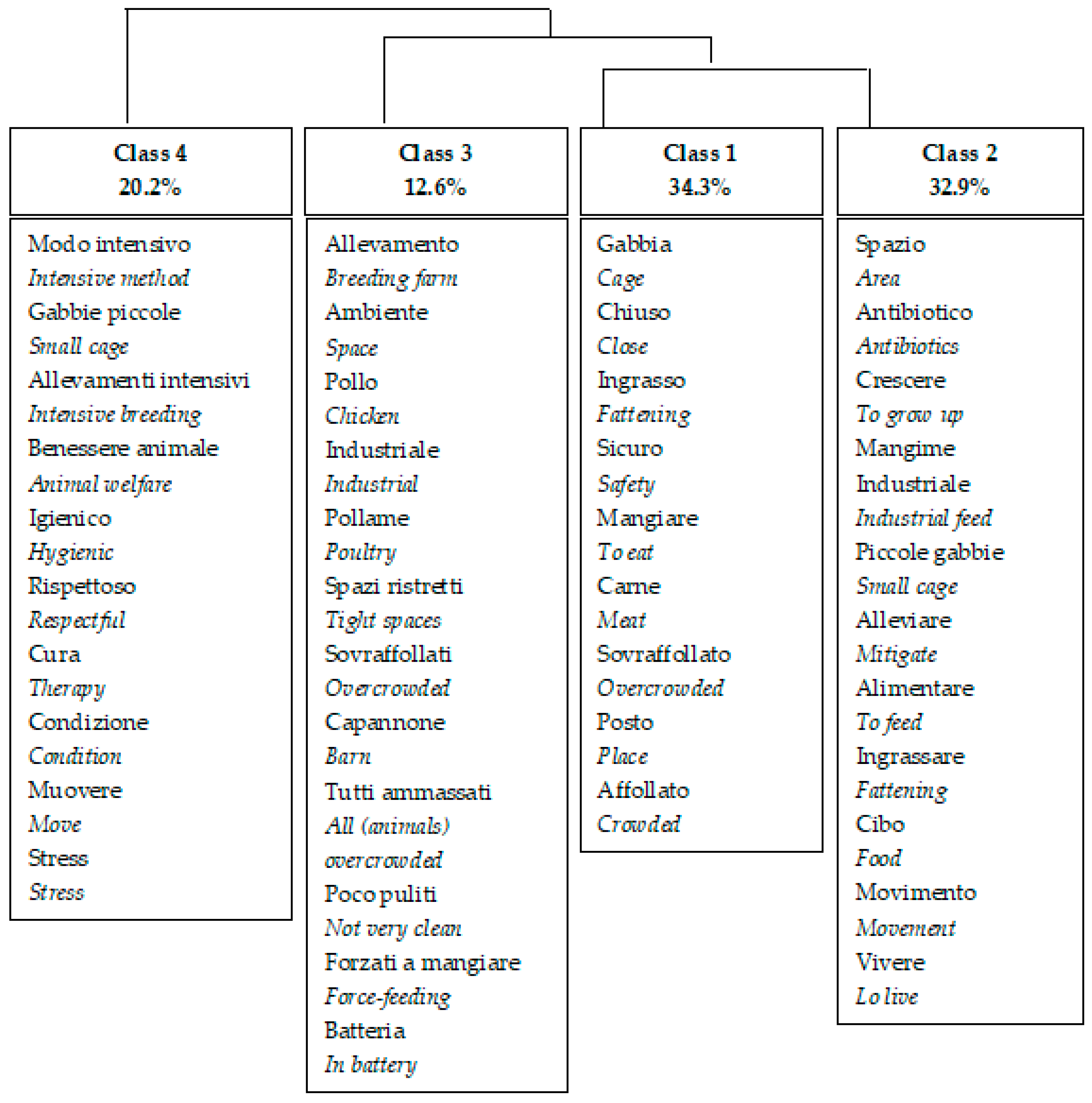
Appendix B
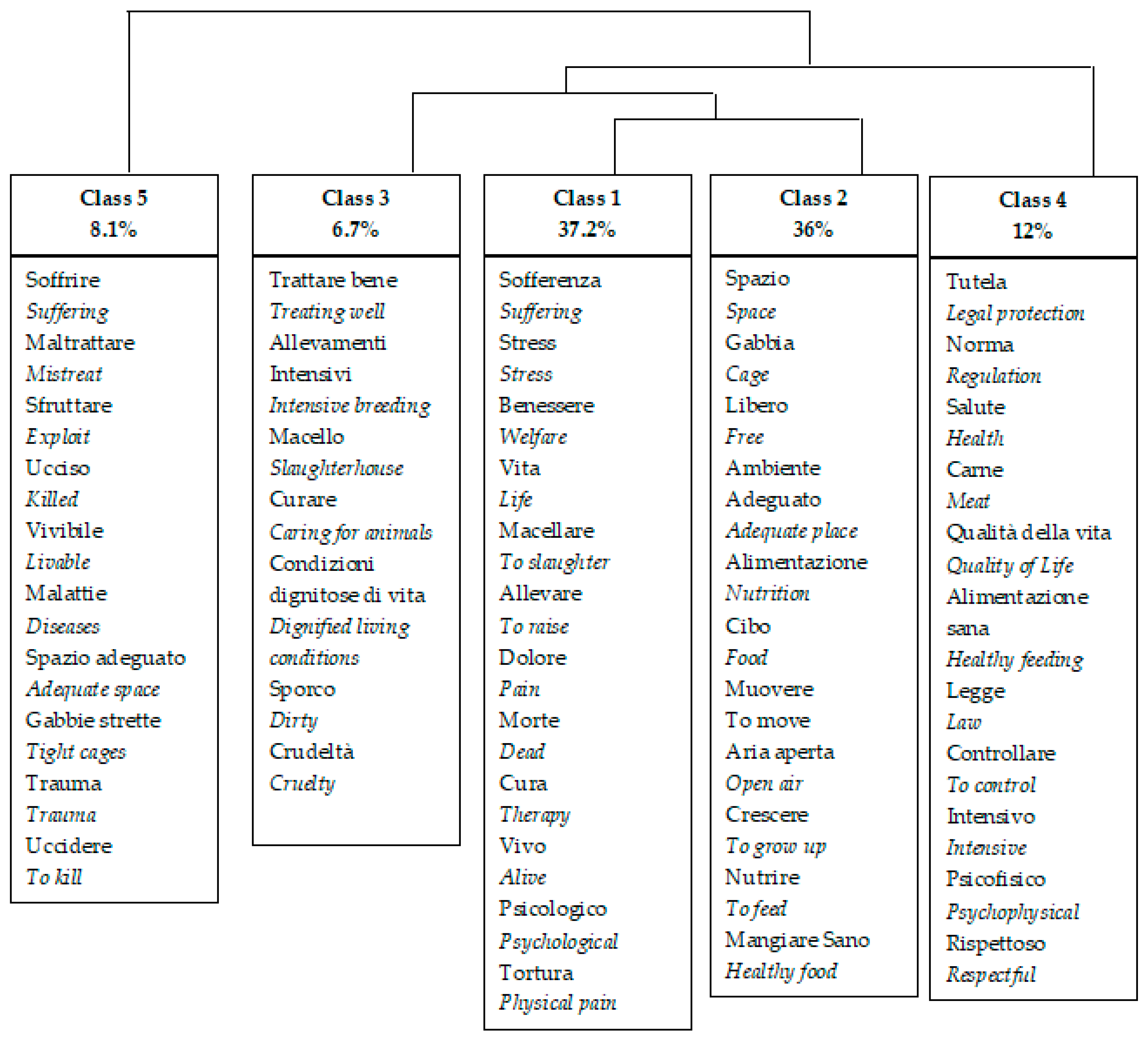
References
- Buitrago Vera, J.M.; Escribá Pérez, C.; Baviera Puig, M.A.; Montero-Vicente, L. Consumer segmentation based on food-related lifestyles and analysis of rabbit meat consumption. World Rabbit Sci. 2016, 24, 169–182. [Google Scholar] [CrossRef] [Green Version]
- European Commission. Overview Report on Commercial Farming of Rabbits in the European Union; Publications Office of the European Union: Luxemburg, 2018. [CrossRef]
- European Parliament. European Parliament Resolution of 10 June 2021 on the European Citizens’ Initiative ‘End the Cage Age’ (2021/2633(RSP). 2021. Available online: https://www.europarl.europa.eu/doceo/document/TA-9-2021-0295_EN.html (accessed on 1 February 2022).
- FAOSTAT. The Statistics Division of the FAO 2020. Available online: http://www.fao.org/faostat/en/#data (accessed on 1 February 2022).
- Trocino, A.; Cotozzolo, E.; Zomeño, C.; Petracci, M.; Xiccato, G.; Castellini, C. Rabbit production and science: The world and Italian scenarios from 1998 to 2018. Ital. J. Anim. Sci. 2019, 18, 1361–1371. [Google Scholar] [CrossRef] [Green Version]
- Petracci, M.; Soglia, F.; Leroy, F. Rabbit meat in need of a hat-trick: From tradition to innovation (and back). Meat Sci. 2018, 146, 93–100. [Google Scholar] [CrossRef] [PubMed]
- González-Redondo, P.; Contreras-Chacón, G.M. Perceptions among university students in Seville (Spain) of the rabbit as livestock and as companion animal. World Rabbit Sci. 2012, 20, 155–162. [Google Scholar] [CrossRef] [Green Version]
- Cullere, M.; Dalle Zotte, A. Rabbit meat production and consumption: State of knowledge and future perspectives. Meat Sci. 2018, 143, 137–146. [Google Scholar] [CrossRef] [PubMed]
- Szendrő, K.; Szabó-Szentgróti, E.; Szigeti, O. Consumers’ Attitude to Consumption of Rabbit Meat in Eight Countries Depending on the Production Method and Its Purchase Form. Foods 2020, 9, 654. [Google Scholar] [CrossRef]
- Bryant, C.; van Nek, L.; Rolland, N. European markets for cultured meat: A comparison of Germany and France. Foods 2020, 9, 1152. [Google Scholar] [CrossRef]
- Ruby, M.B. Vegetarianism. A blossoming field of study. Appetite 2012, 58, 141–150. [Google Scholar] [CrossRef]
- EFSA Panel on Animal Health and Welfare (AHAW); Saxmose Nielsen, S.; Alvarez, J.; Bicout, D.J.; Calistri, P.; Depner, K.; Drewe, J.A.; Garin-Bastuji, B.; Gonzales Rojas, J.L.; Gortázar Schmidt, C.; et al. Health and welfare of rabbits farmed in different production systems. EFSA J. 2020, 18, e05944. [Google Scholar]
- Mondin, C.; Trestini, S.; Trocino, A.; Di Martino, G. The Economics of Rabbit Farming: A Pilot Study on the Impact of Different Housing Systems. Animals 2021, 11, 3040. [Google Scholar] [CrossRef] [PubMed]
- Creswell, J.W. Qualitative inquiry and research design. In Choosing among Five Approaches, 2nd ed.; Sage Publications: Thousand Oaks, CA, USA, 2007. [Google Scholar]
- Stockemer, D.; Stockemer, G.; Glaeser. Quantitative Methods for the Social Sciences; Springer International Publishing: Cham, Switzerland, 2019; Volume 50, p. 185. [Google Scholar]
- Creswell, J.W.; Plano Clark, V.L. Designing and Conducting Mixed Methods Research, 2nd ed.; Sage Publications: Thousand Oaks, CA, USA, 2011. [Google Scholar]
- Feldman, R.; Sanger, J. The Text Mining Handbook: Advanced Approaches in Analyzing Unstructured Data; Cambridge University Press: Cambridge, UK, 2007. [Google Scholar]
- Bolasco, S.; Baiocchi, F.; Morrone, A. TaLTaC2: Trattamento Automatico Lessicale e Testuale per L’analisi del Contenuto di un Corpus. 2000. Available online: https://www.docenti.unina.it/webdocenti-be/allegati/materiale-didattico/666335 (accessed on 1 February 2022).
- Bolasco, S. Taltac 2.10. In Sviluppi, Esperienze ed Elementi Essenziali di Analisi Automatica dei Testi; LED: Milano, Italy, 2010. [Google Scholar]
- Reinert, M. Unlogiciel d’analyse Lexicale. Cah. Anal. Donnees 1986, 11, 471–481. [Google Scholar]
- Ratinaud, P. IRaMuTeQ: Interface de R pour LesAnalyses Multidimensionnelles de Textes et de Ques-Tionnaires. 2009. Available online: http://www.iramuteq.org/documentation/fichiers/Pas%20a%20Pas%20IRAMUTEQ_0.7alpha2.pdf (accessed on 1 February 2022).
- Tuzzi, A. L’analisi del Contenuto: Introduzione ai Metodi a alle Tecniche di Ricerca; Carrocci: Roma, Italy, 2003. [Google Scholar]
- Tiozzo, B.; Ruzza, M.; Rizzoli, V.; D’Este, L.; Giaretta, M.; Ravarotto, L. Biological, chemical, and nutritional food risks and food safety issues from Italian online information sources: Web monitoring, content analysis, and data visualization. J. Med. Internet Res. 2020, 22, e23438. [Google Scholar] [CrossRef] [PubMed]
- Rizzoli, V.; Mascarello, G.; Pinto, A.; Crovato, S.; Ruzza, M.; Tiozzo, B.; Ravarotto, L. ‘Don’t Worry, Honey: It’s Cooked’: Addressing Food Risk during Pregnancy on Facebook Italian Posts. Foods 2021, 10, 2484. [Google Scholar] [CrossRef] [PubMed]
- Reinert, M. Les “mondes lexicaux” et leur ‘logique” à travers l’analyse statistique d’ un corpus de récits de cauchemars. Lang. Société 1993, 66, 5–39. [Google Scholar] [CrossRef]
- Szakaly, Z.; Szigeti, O.; Szente, V. Analysis of consumer habits and attitudes on the Hungarian beef and rabbit market. APSTRACT: Appl. Stud. Agribus. Commer. 2009, 3, 67–70. [Google Scholar] [CrossRef] [PubMed]
- Merlino, V.; Massaglia, S.; Borra, D. Analysis of European consumer awareness for identifying animal-friendly meat. Qual.-Access Success 2019, 20, 388–395. [Google Scholar]
- Napolitano, F.; Girolami, A.; Braghieri, A. Consumer liking and willingness to pay for high welfare animal-based products. Trends Food Sci. Technol. 2010, 21, 537–543. [Google Scholar] [CrossRef]
- Grunert, K.G.; Bredahl, L.; Brunsø, K. Consumer perception of meat quality and implications for product development in the meat sector—A review. Meat Sci. 2004, 66, 259–272. [Google Scholar] [CrossRef]
- Carlucci, A.; Monteleone, E.; Braghieri, A.; Napolitano, F. Mapping the effect of information about animal welfare on consumer liking and willingness to pay for yogurt. J. Sens. Stud. 2009, 24, 712–730. [Google Scholar] [CrossRef]
- Vanhonacker, F.; Verbeke, W.; Poucke, E.V.; Tuyttens, F.A.M. Do citizens and farmers interpret the concept of farm animal welfare differently? Livest. Sci. 2008, 116, 126–136. [Google Scholar] [CrossRef]
- Troy, D.J.; Kerry, J.P. Consumer perception and the role of science in the meat industry. Meat Sci. 2010, 86, 214–226. [Google Scholar] [CrossRef]
- Toma, L.; Stott, A.W.; Revoredo-Giha, C.; Kupiec-Teahan, B. Consumers and animal welfare. A comparison between European Union countries. Appetite 2012, 58, 597–607. [Google Scholar] [CrossRef] [PubMed]
- Matarrese, A.M. Slow Food Policy Paper on Animal Welfare. 2013. Available online: https://www.slowfood.com/wp-content/uploads/2020/12/ING_position_paper_animal_welfare.pdf (accessed on 1 February 2022).
- Merlino, V.M.; Borra, D.; Girgenti, V.; Dal Vecchio, A.; Massaglia, S. Beef meat preferences of consumers from Northwest Italy: Analysis of choice attributes. Meat Sci. 2018, 143, 119–128. [Google Scholar] [CrossRef] [PubMed]
- Di Pasquale, J.; Nannoni, E.; Del Duca, I.; Adinolfi, F.; Capitanio, F.; Sardi, L.; Vitali, M.; Martelli, G. What foods are identified as animal friendly by Italian consumers? Ital. J. Anim. Sci. 2014, 13, 3582. [Google Scholar] [CrossRef] [Green Version]
- Eurobarometer. Special. In Attitudes of EU Citizens towards Animal Welfare; European Commission: Brussels, Belgium, 2007; Available online: https://europa.eu/eurobarometer/surveys/detail/470 (accessed on 1 February 2022).
- Tonkin, E.; Meyer, S.B.; Coveney, J.; Webb, T.; Wilson, A.M. The process of making trust related judgements through interaction with food labelling. Food Policy 2016, 63, 1–11. [Google Scholar] [CrossRef] [Green Version]
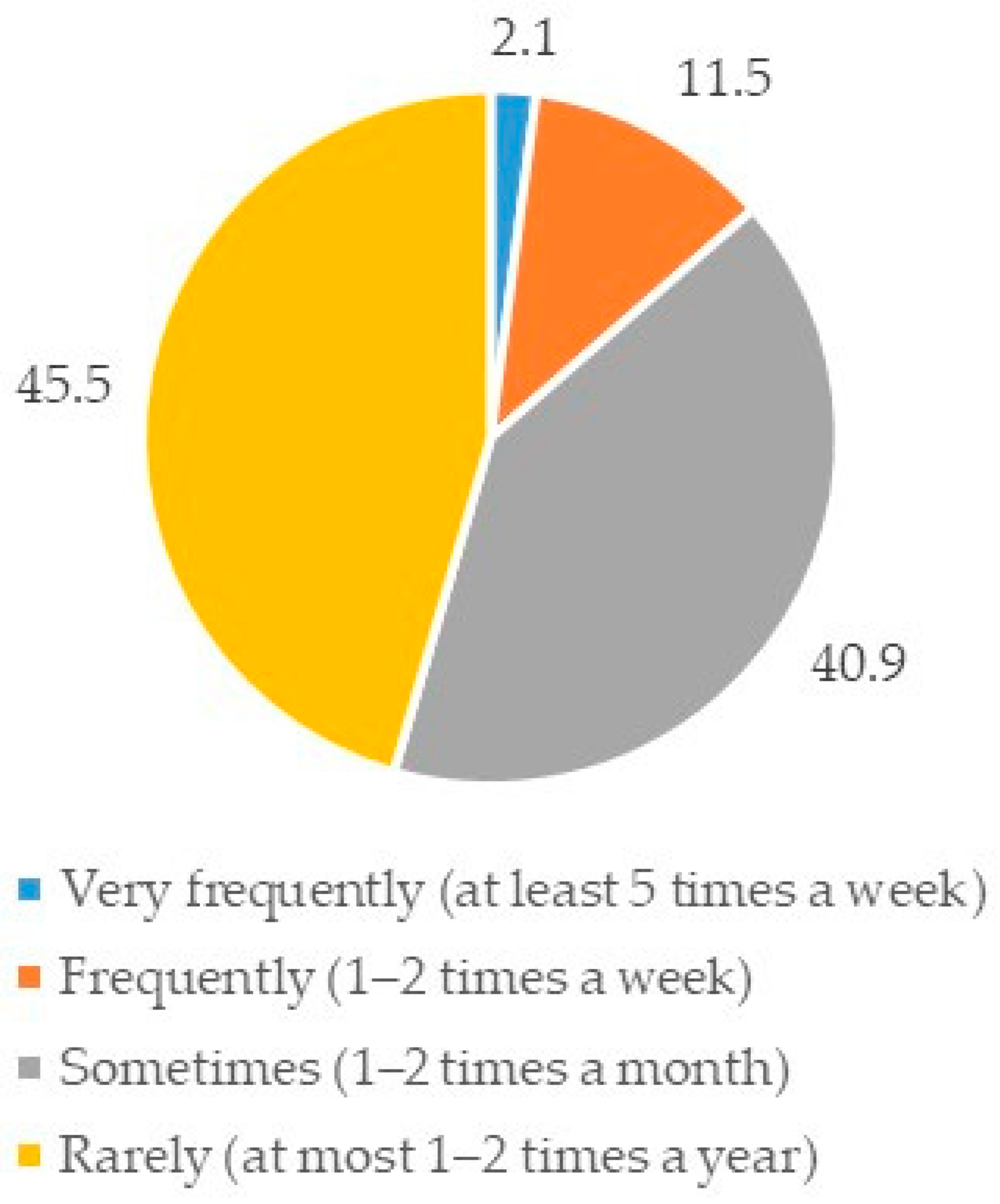
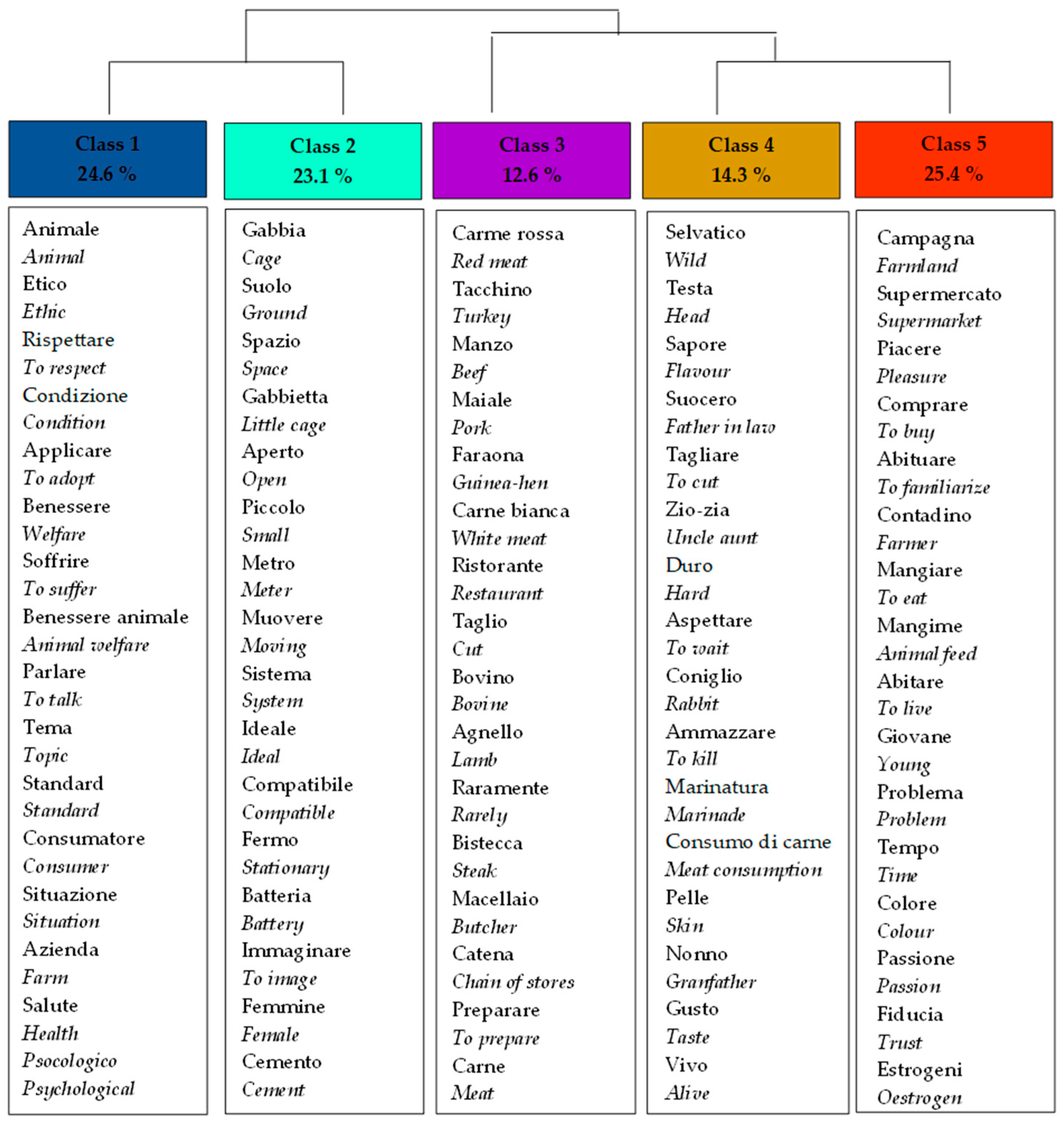
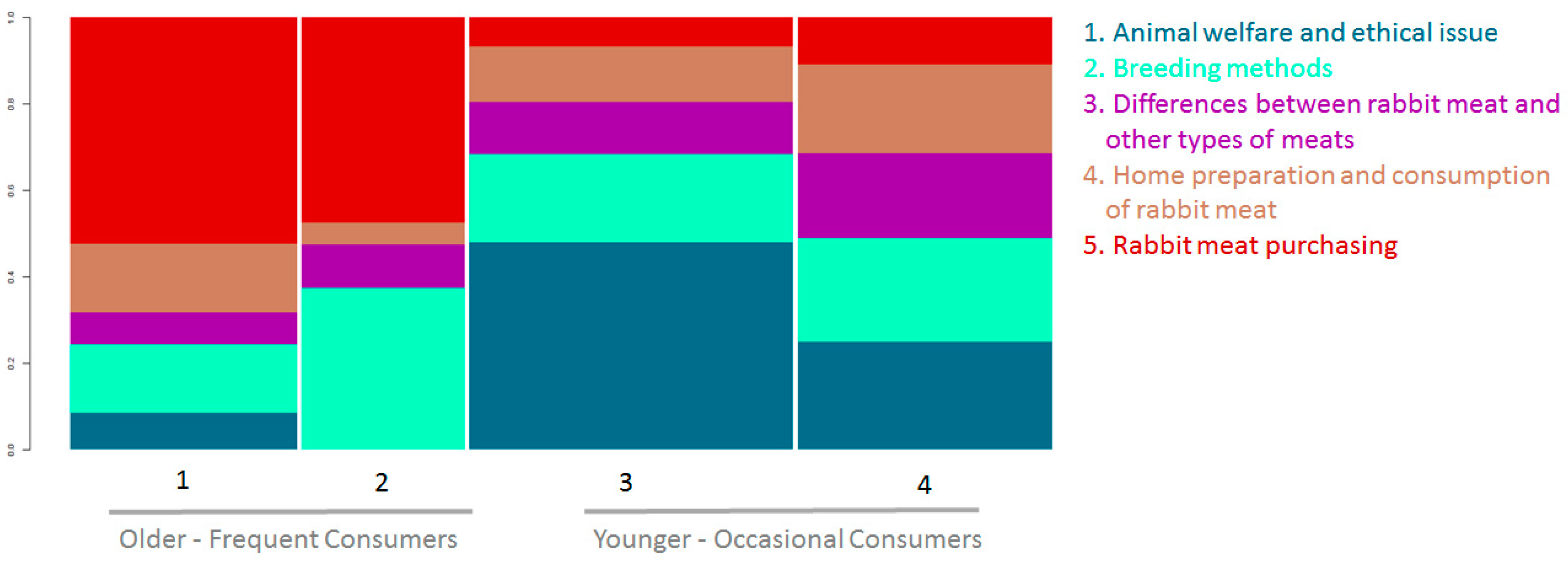
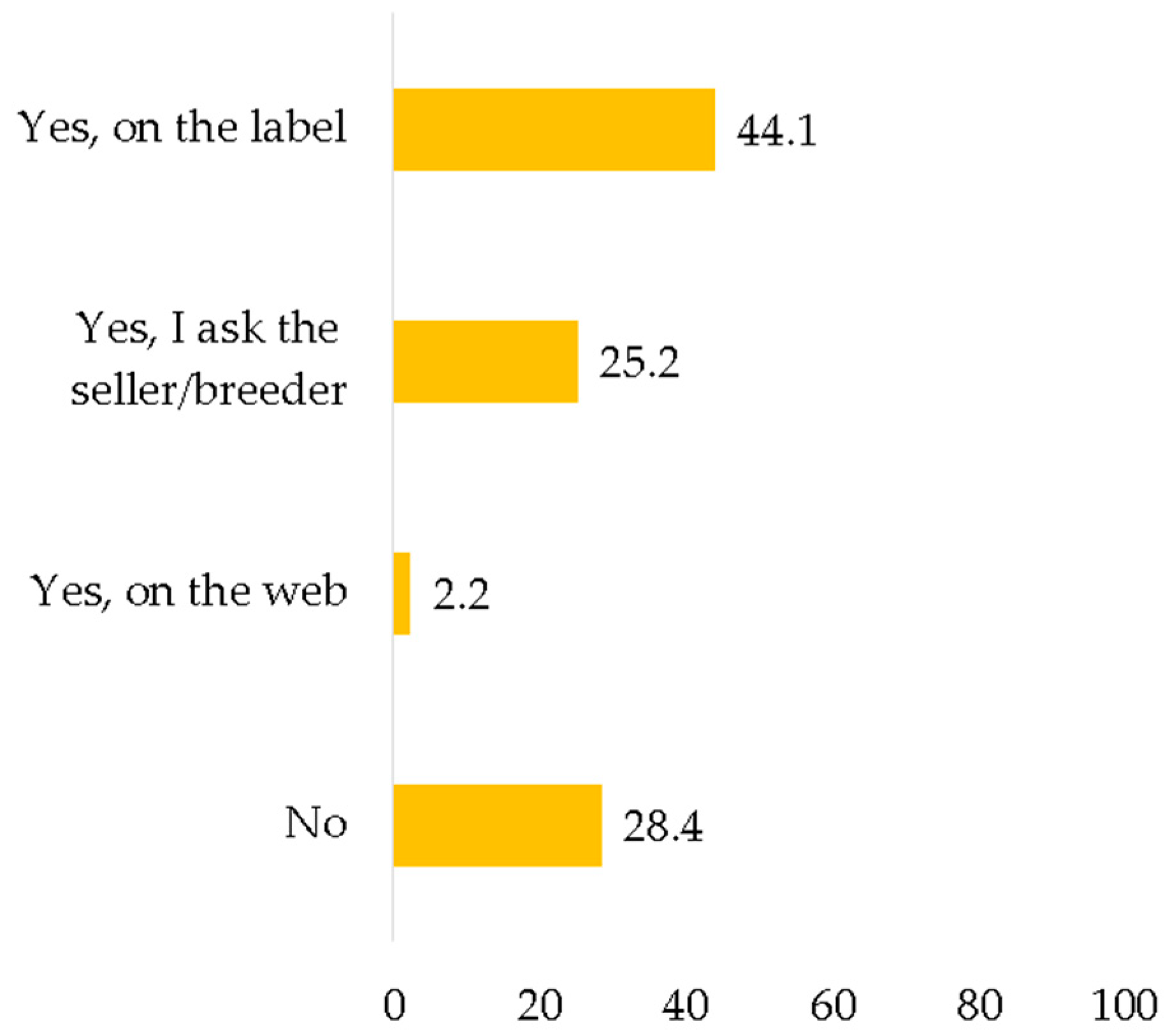
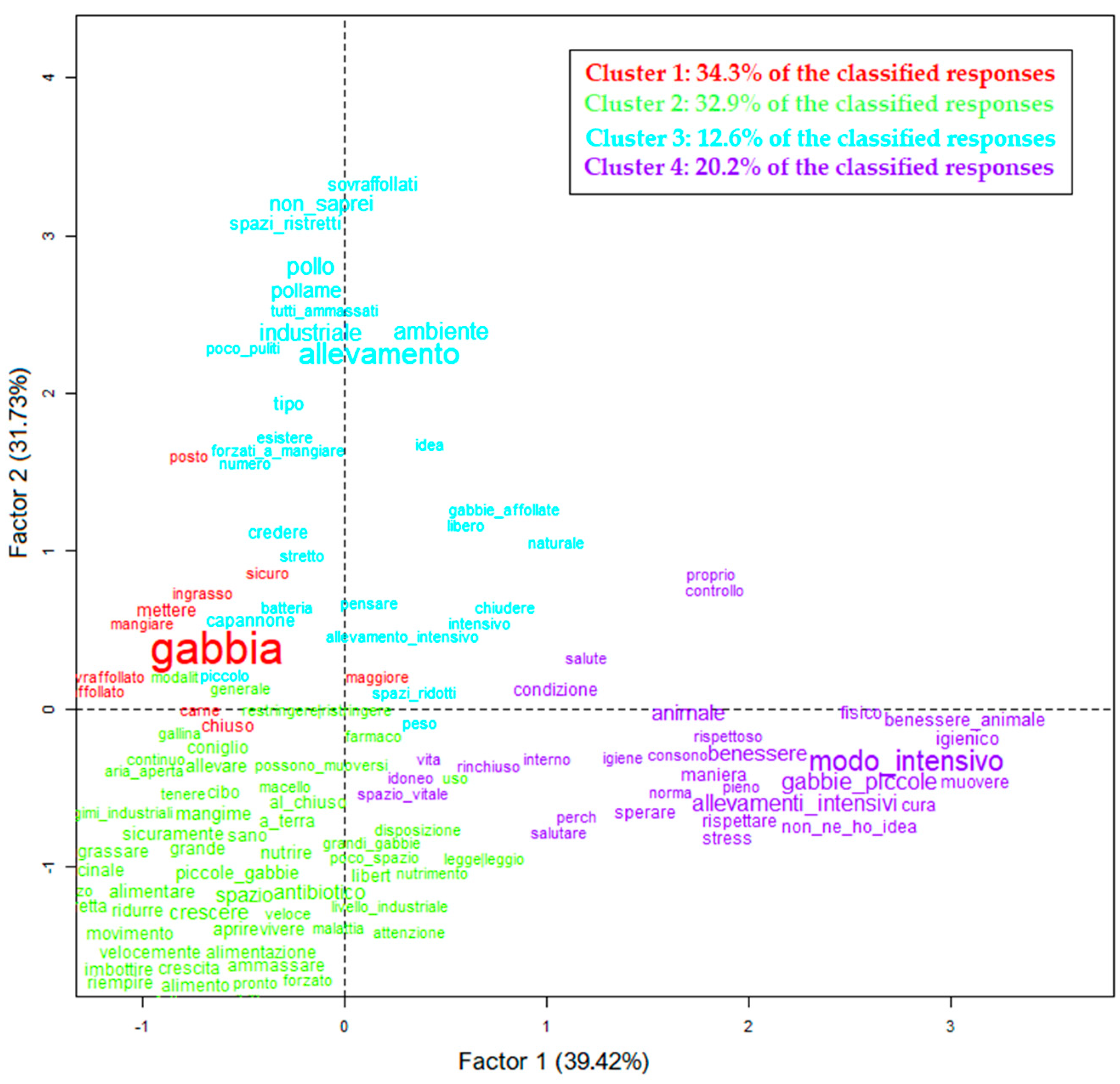
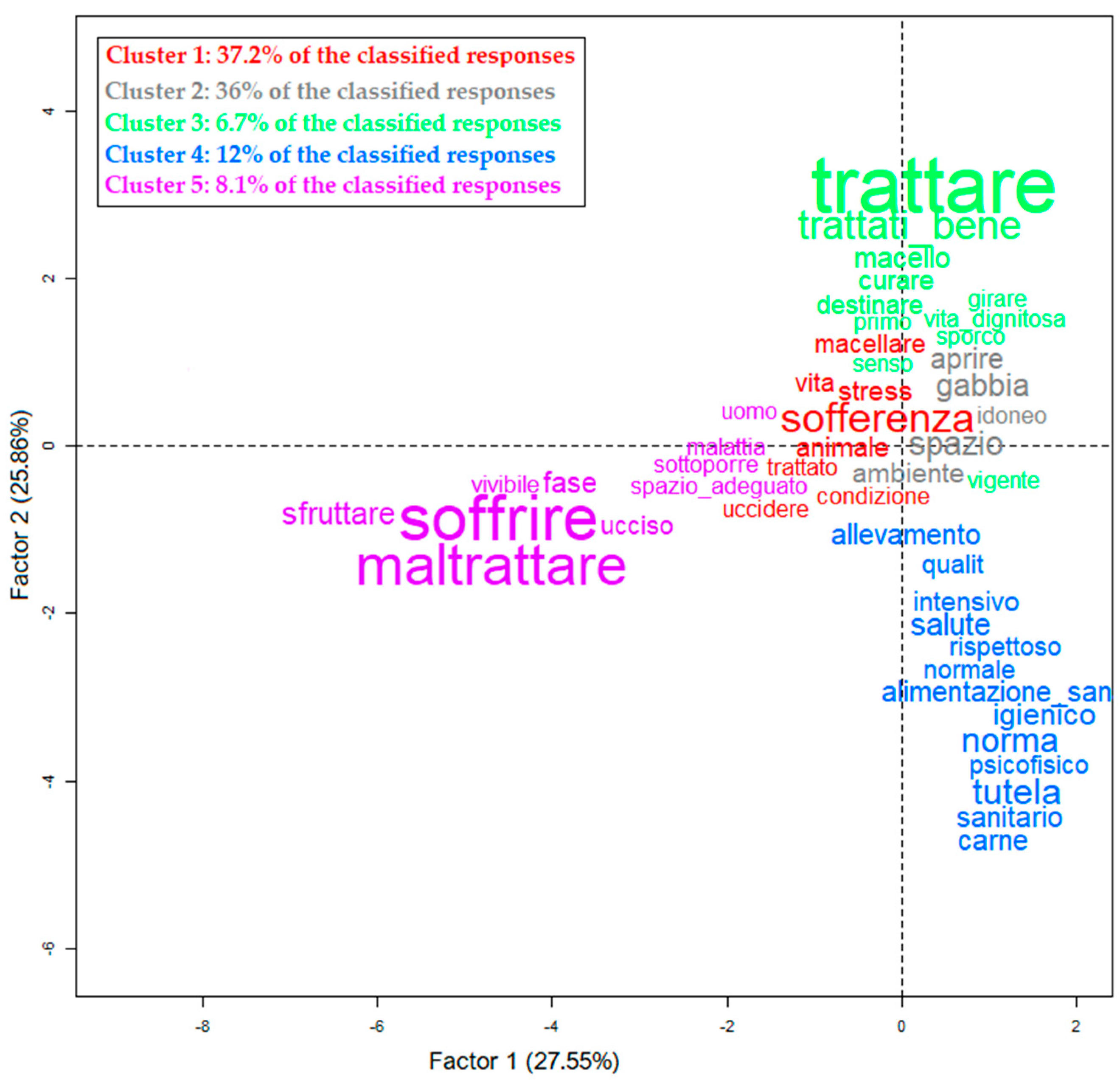
| Sections | Questions | Type of Question (Open-Close) |
|---|---|---|
| (1) Rabbit meat consumption and purchase |
| Close—More options |
| Close—More options | |
| Close—More options | |
| Close—Likert scale (1–10) | |
| Close—Yes/No | |
| (2) Knowledge and perception of rabbit breeding and animal welfare |
| Close—Yes/No/I don’t know |
| Open | |
| Close—strongly/somewhat/slightly/not at all agree | |
| Close—Yes/No | |
| Open | |
| Close—Yes/No/I don’t know | |
| Close—Yes/No | |
| (3) Socio-demographic characteristics of respondents |
| Close—More options |
| Open |
| Focus Groups | Survey Question (1) | Survey Question (2) | |
|---|---|---|---|
| Number of occurrences (Token) | 24,844 | 8480 | 4975 |
| Number of distinct forms (Type) | 3458 | 1248 | 976 |
| Type/token ratio | 13.9 | 14.7 | 19.6 |
| Words that appear only once (Hapax) | 54.7 | 54.4 | 62.3 |
| Characteristics | % |
|---|---|
| Gender | |
| Female | 48.2 |
| Male | 51.8 |
| Where they live in Italy | |
| Nord-West | 26.7 |
| Nord-East | 18.7 |
| Centre | 20.3 |
| South & Islands | 34.3 |
| Age groups | |
| 18–35 years | 25.2 |
| 36–48 years | 26.0 |
| 49–60 years | 25.4 |
| 61–78 years | 23.4 |
| Educational qualification | |
| Primary/lower secondary school | 9.8 |
| Professional qualification/higher secondary school diploma | 57.7 |
| University diploma/Degree/Post-graduate specialization | 32.4 |
| Occupation | |
| Student | 8.2 |
| Looking for his first job | 2.3 |
| Homemaker | 12.6 |
| Employed | 50.8 |
| Unemployed | 7.8 |
| Retired | 18.3 |
| Financial condition (at the end of the month) | |
| Very easy | 8.8 |
| Quite easy | 42.6 |
| With some difficulties | 42.0 |
| With many difficulties | 6.7 |
| Living with | |
| Partner & children | 33.6 |
| Partner | 23.8 |
| Elderly household (with parents) | 16.6 |
| Alone | 11.9 |
| Only children | 11.5 |
| Other | 2.6 |
| Group | Type of Consumers | N | Age (Mean) |
|---|---|---|---|
| 1 | Older—frequent | 9 | 66 |
| 2 | Older—frequent | 11 | 69 |
| 3 | Younger—occasional | 6 | 34 |
| 4 | Younger—occasional | 6 | 39 |
| Factors | Total Mean (n = 503) | Mean Respondents Aged 48 or under (n = 233) | Mean Respondents Aged over 48 (n = 270) | p-Value |
|---|---|---|---|---|
| It has been bred with the responsible use of antibiotics | 8.09 | 8.05 | 8.13 | 0.662 |
| It looks good | 7.92 | 8.07 | 7.80 | 0.099 |
| It has been raised without suffering | 7.46 | 7.42 | 7.49 | 0.733 |
| It comes from farms with a low environmental impact | 7.35 | 7.33 | 7.36 | 0.904 |
| It is organically farmed | 7.21 | 7.29 | 7.14 | 0.459 |
| It was produced close to home | 7.04 | 7.02 | 7.06 | 0.816 |
| It can be purchased directly from the breeder | 6.91 | 7.01 | 6.82 | 0.378 |
| It is a known brand | 5.91 | 6.11 | 5.74 | 0.098 |
| It is economical | 5.74 | 5.88 | 5.61 | 0.176 |
| Statements | Overall Sample (%, n = 1001) | Respondents Aged 48 or under (%, n = 504) | Respondents Aged over 48 (%, n = 497) | p-Value |
|---|---|---|---|---|
| Farming methods affect the safety of the meat we eat | ||||
| Somewhat-strongly agree | 90.2 | 88.7 | 91.8 | 0.111 |
| Not at all/slightly agree | 9.8 | 11.3 | 8.2 | |
| In recent years, consumers’ interest in the way animals are raised has increased | ||||
| Somewhat-strongly agree | 88.2 | 87.5 | 88.9 | 0.494 |
| Not at all/slightly agree | 11.8 | 12.5 | 11.1 | |
| Only animals reared in the open air live in animal welfare conditions | ||||
| Somewhat-strongly agree | 84.1 | 80.2 | 88.1 | 0.001 |
| Not at all/slightly agree | 15.9 | 19.8 | 11.9 | |
| Meat from industrial farms is less tasty than meat from non-industrial farms | ||||
| Somewhat-strongly agree | 81.2 | 78.4 | 84.1 | 0.023 |
| Not at all/slightly agree | 18.8 | 21.6 | 15.9 | |
| Meat from industrial farms is safer than meat from non-industrial farms | ||||
| Somewhat-strongly agree | 43.3 | 39.9 | 46.7 | 0.030 |
| Not at all/slightly agree | 56.7 | 60.1 | 53.3 | |
| Industrial livestock farms are careful to protect the animal’s welfare | ||||
| Somewhat-strongly agree | 30.9 | 31.3 | 30.4 | 0.784 |
| Not at all/slightly agree | 69.1 | 68.7 | 69.6 |
| Conditions | Overall Sample (%, n = 1001) | Respondents Aged 48 or under (%, n = 504) | Respondents Aged over 48 (%, n = 497) | p-Value |
|---|---|---|---|---|
| Measures to reduce antibiotic use | ||||
| Surely yes | 70.1 | 64.9 | 75.5 | 0.001 |
| Yes, but it depends on the final cost | 26.7 | 31.0 | 22.3 | |
| No | 3.2 | 4.1 | 2.2 | |
| Measures to reduce the environmental impact of livestock farming | ||||
| Surely yes | 56.7 | 53.2 | 60.4 | 0.049 |
| Yes, but it depends on the final cost | 39.2 | 41.9 | 36.4 | |
| No | 4.1 | 4.9 | 3.2 | |
| Measures for the adoption of alternative livestock farming systems over intensive | ||||
| Surely yes | 55.5 | 49.4 | 61.8 | 0.000 |
| Yes, but it depends on the final cost | 39.9 | 44.8 | 34.8 | |
| No | 4.6 | 5.8 | 3.4 | |
| Conditions protecting the animal welfare | ||||
| Surely yes | 50.4 | 45.8 | 55.1 | 0.013 |
| Yes, but it depends on the final cost | 46.5 | 50.8 | 42.1 | |
| No | 3.1 | 3.4 | 2.8 |
Publisher’s Note: MDPI stays neutral with regard to jurisdictional claims in published maps and institutional affiliations. |
© 2022 by the authors. Licensee MDPI, Basel, Switzerland. This article is an open access article distributed under the terms and conditions of the Creative Commons Attribution (CC BY) license (https://creativecommons.org/licenses/by/4.0/).
Share and Cite
Crovato, S.; Pinto, A.; Di Martino, G.; Mascarello, G.; Rizzoli, V.; Marcolin, S.; Ravarotto, L. Purchasing Habits, Sustainability Perceptions, and Welfare Concerns of Italian Consumers Regarding Rabbit Meat. Foods 2022, 11, 1205. https://doi.org/10.3390/foods11091205
Crovato S, Pinto A, Di Martino G, Mascarello G, Rizzoli V, Marcolin S, Ravarotto L. Purchasing Habits, Sustainability Perceptions, and Welfare Concerns of Italian Consumers Regarding Rabbit Meat. Foods. 2022; 11(9):1205. https://doi.org/10.3390/foods11091205
Chicago/Turabian StyleCrovato, Stefania, Anna Pinto, Guido Di Martino, Giulia Mascarello, Valentina Rizzoli, Silvia Marcolin, and Licia Ravarotto. 2022. "Purchasing Habits, Sustainability Perceptions, and Welfare Concerns of Italian Consumers Regarding Rabbit Meat" Foods 11, no. 9: 1205. https://doi.org/10.3390/foods11091205
APA StyleCrovato, S., Pinto, A., Di Martino, G., Mascarello, G., Rizzoli, V., Marcolin, S., & Ravarotto, L. (2022). Purchasing Habits, Sustainability Perceptions, and Welfare Concerns of Italian Consumers Regarding Rabbit Meat. Foods, 11(9), 1205. https://doi.org/10.3390/foods11091205






